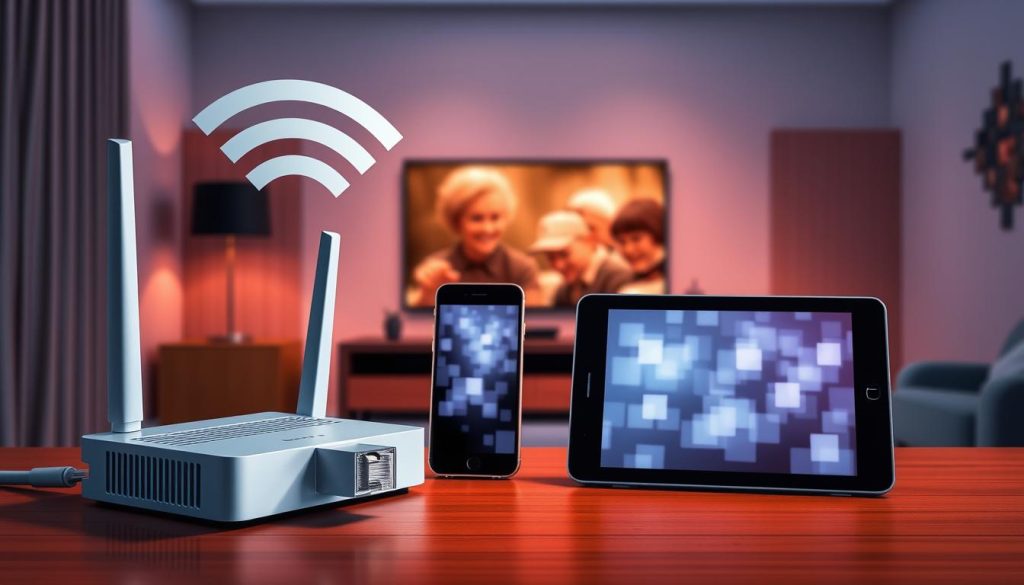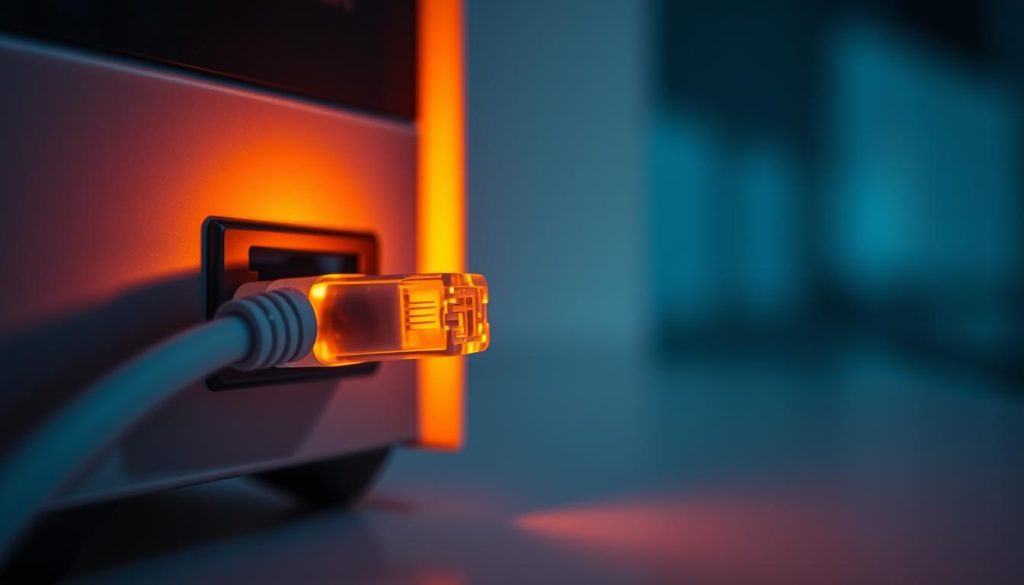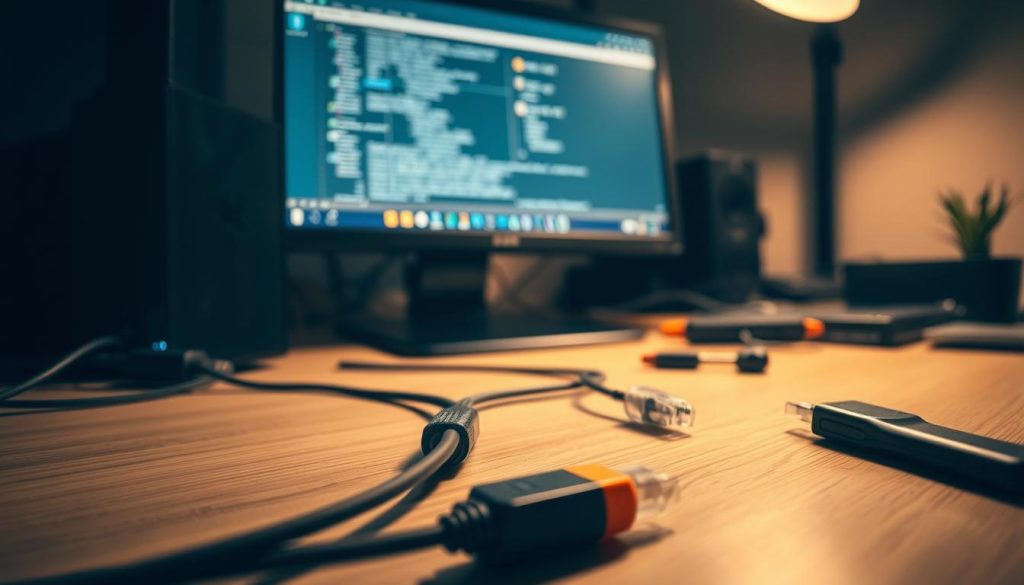Many people are searching for the best way to stream IPTV without interruptions. They wonder about the difference between using an Ethernet cable and WiFi. This is important for getting the best streaming experience.
Using an Ethernet cable can make your streaming better. It’s less likely to get interrupted like WiFi. For HD streaming, you need at least 25 Mbps internet speed1. This makes Ethernet a key part of a great IPTV setup.
For IPTV streaming, you need the right internet speed. SD needs at least 3 Mbps, and 4K needs 25 Mbps or more2. This shows how important a stable internet connection is for quality streaming. Knowing about Ethernet vs WiFi is key for the best streaming.
Table of Contents
ToggleKey Takeaways
- Using an Ethernet cable can improve IPTV streaming quality by reducing interference and speed fluctuations.
- A minimum internet speed of 25 Mbps is recommended for HD streaming, and 50 Mbps or higher for 4K content1.
- Internet speed requirements for IPTV streaming vary, with SD requiring at least 3 Mbps, and 4K requiring 25 Mbps or higher2.
- Understanding iptv connection type and iptv ethernet vs wifi is crucial for a seamless streaming experience.
- Investing in a premium IPTV service can guarantee better streaming quality, more channels, and higher server uptime1.
- Configuring QoS settings in routers can prioritize IPTV traffic to enhance streaming quality, even during busy times2.
Understanding IPTV Network Connectivity Basics
IPTV uses the Transmission Control Protocol/Internet Protocol (TCP/IP) suite, unlike traditional TV methods3. This lets IPTV offer flexible services like video on demand and interactive TV3. The network connection type greatly affects IPTV speed and reliability, with Ethernet being faster and more stable than WiFi.
When comparing IPTV connections, consider network congestion, latency, and speed4. Using CAT6 cables supports speeds up to 10 Gbps, and IGMP snooping can reduce network load by up to 60%4. Understanding these factors helps optimize IPTV network speed and reliability for a better streaming experience.
The Fundamental Differences Between Ethernet and WiFi for IPTV
Because of these differences, Ethernet is usually the better choice for ethernet vs wifi for iptv due to its reliability and speed6. Yet, the decision between Ethernet and WiFi depends on your specific needs. Knowing the pros and cons of each helps users pick the best connection for iptv for them.
Why Ethernet Cables Enhance IPTV Performance
For IPTV streaming, a fast and stable connection is key. Ethernet cables bring speed and stability, vital for top-notch streaming. They offer faster data transfer, making playback smoother and cutting down on buffering.
They’re great when many devices are on the same network. Ethernet provides a steadier connection than Wi-Fi7.
In summary, Ethernet cables make IPTV streaming better. They offer faster, more stable connections and less latency. With Ethernet, you get uninterrupted, high-quality streaming7.
Common WiFi Issues Affecting IPTV Streaming

For IPTV streaming, a strong and fast internet connection is key. But WiFi can have problems that hurt IPTV streaming quality. Signal strength can be weak due to physical barriers, distance, and other device interference9. Also, not enough bandwidth can cause buffering, lag, and poor video quality. You need at least 3-5 Mbps for SD and 5-10 Mbps for HD IPTV content10.
Other devices and networks can also mess with IPTV streaming. With more devices online, they can use up to 80% of bandwidth, causing IPTV playback issues9. About 30% of users face server problems due to high traffic, affecting their IPTV streaming quality9. To solve these problems, it’s important to think about the wifi vs ethernet for iptv debate and the benefits of wired connections for IPTV streaming.
A iptv wifi streaming comparison shows WiFi has signal and interference issues. Ethernet, on the other hand, offers a stable and reliable connection. It can cut buffering by up to 70% compared to WiFi9. As IPTV streaming gets more popular, we need to tackle wifi issues for iptv and look at other solutions like Ethernet connections for a smooth viewing experience.
IPTV Ethernet vs WiFi: A Comprehensive Comparison
Choosing between Ethernet and WiFi for IPTV streaming can greatly change your viewing experience. Ethernet is known for its fast and stable speeds, perfect for streaming high-quality content. WiFi, on the other hand, can be affected by interference and latency, which might lower the stream quality.
Looking at ethernet vs wifi speed for streaming, Ethernet cables can reach speeds of up to 10 Gbps, like Cat6 cables11. WiFi speeds vary, but dual-band WiFi can go up to 540 Mbps on the 5 GHz band12. For a smooth viewing experience, it’s key to consider these speeds in your iptv connection comparison.
Reliability is also a big factor in the iptv ethernet vs wifi comparison. Ethernet is more reliable and less affected by interference, making it great for IPTV streaming. WiFi, though, can be impacted by distance, physical barriers, and other device interference. About 60% of consumers prefer using Wi-Fi for streaming devices11, showing a trend towards wireless solutions.
Setting Up Your Ethernet Connection for IPTV

Setting up an ethernet connection for iptv needs careful thought about the gear and how to install it. You’ll need an Ethernet cable, a router, and an IPTV device13. A detailed guide can make setting up fast and simple, giving you a stable and secure iptv ethernet setup.
When picking your gear, think about the Ethernet cable type. Gigabit Ethernet cables can go up to 1000 Mbps, perfect for IPTV’s high speeds5. Also, choose a cable that fights off interference well and has a top-notch connector for a solid connection.
To get the best results, follow a detailed guide for your setting up iptv ethernet connection. This way, you can dodge common errors and get a secure, stable link13. Spending time on setting up your Ethernet for IPTV means better streaming without hitches.
Optimizing Your IPTV Network Performance
Improving your IPTV network is key for a smooth viewing experience. This means using a top-notch router, tweaking WiFi settings, and controlling apps that use a lot of bandwidth. IPTV can use up to 20 Mbps per viewer for HD streaming14. It’s important to have enough bandwidth to avoid buffering and slow speeds during high IPTV usage14.
Setting up Quality of Service (QoS) settings is also crucial. It helps make sure IPTV gets priority over other network traffic. This improves how well your network handles congestion and packet loss14. Also, using multicast technology can cut down on bandwidth use by sending data to many places at once14. Keeping an eye on bandwidth, QoS, latency, jitter, and packet loss is vital for top network performance14.
For better IPTV streaming, you need a fast internet connection. Aim for 7-10 Mbps download and 1-3 Mbps upload speeds15. For a wired connection, 25 Mbps is recommended15. For Wi-Fi, you’ll need at least 150 Mbps, depending on your home setup15. Using the right gear, like Ethernet cables that go up to 10 Gbps with Cat 6 cables16, can help optimize your IPTV network for a better viewing experience.
Troubleshooting Common Ethernet Connection Issues

When to Choose WiFi Over Ethernet for IPTV
While Ethernet is often the top choice for IPTV, WiFi has its own advantages. It’s better when you need to move around or can’t use Ethernet cables19. WiFi offers flexibility and convenience, perfect for streaming in different rooms without cables.
Practical Scenarios
WiFi is a good choice when Ethernet cables are not practical or too costly. In big homes or buildings, WiFi is easier to set up than Ethernet. It also makes adding or removing devices simple, making it a flexible option for IPTV.
Alternative Solutions
If you prefer Ethernet but can’t install cables, Power over Ethernet (POE) is a solution. POE sends power, TV signal, and internet over one cable19. It’s a handy option for IPTV. The choice between WiFi and Ethernet depends on your needs and setup. Weighing the pros and cons of each can help you decide13.
Conclusion: Making the Right Choice for Your IPTV Setup
Choosing the right connection type for your IPTV setup is key for a smooth viewing experience. Both IPTV subscription services and providers offer top-notch content. But, the network connection you choose can greatly affect how well it works.
FAQ
What is IPTV streaming?
IPTV (Internet Protocol Television) lets you watch TV over the internet. You can stream live TV, on-demand shows, and more.
What are the different types of network connections for IPTV?
IPTV uses two main connections: Ethernet (wired) and WiFi (wireless). Each has its own pros and cons that affect streaming quality.
How does the connection type affect IPTV streaming quality?
The connection type greatly affects IPTV quality. Speed, latency, and interference vary between Ethernet and WiFi. This impacts the smoothness and reliability of your IPTV experience.
What are the fundamental differences between Ethernet and WiFi for IPTV?
Ethernet and WiFi differ in speed, latency, stability, and interference. Ethernet is faster, more stable, and less prone to interference. WiFi is more convenient but may face signal and bandwidth issues.
Why do Ethernet cables enhance IPTV performance?
Ethernet cables offer faster, more stable internet. They reduce latency and buffer times. This makes IPTV streaming smoother and more reliable than WiFi.
What are the common WiFi issues that can affect IPTV streaming?
WiFi issues like signal strength changes, interference, and bandwidth limits can harm IPTV streaming. These can cause buffering, pixelation, and drops in connection.
How do Ethernet and WiFi compare in terms of IPTV performance?
Ethernet outperforms WiFi for IPTV. It offers faster speeds, lower latency, and better interference resistance. This results in a smoother IPTV experience.
How do I set up an Ethernet connection for IPTV?
To set up Ethernet for IPTV, connect an Ethernet cable from your router to your IPTV device. Make sure the cable is compatible and installed correctly. You might need to adjust your IPTV settings to use the Ethernet connection.
How can I optimize my IPTV network performance?
To improve IPTV network performance, place your router correctly, reduce wireless interference, upgrade your internet plan, and use quality Ethernet cables. Proper setup and maintenance can enhance your IPTV streaming.
How do I troubleshoot common Ethernet connection issues for IPTV?
Troubleshoot Ethernet issues like drops, speed problems, and compatibility by checking cable connections, updating drivers, and ensuring compatibility between your IPTV device and Ethernet setup.
When should I choose WiFi over Ethernet for IPTV?
Choose WiFi when Ethernet cables are not possible. To improve WiFi for IPTV, use a wireless access point or repeater. This can enhance your streaming experience.


